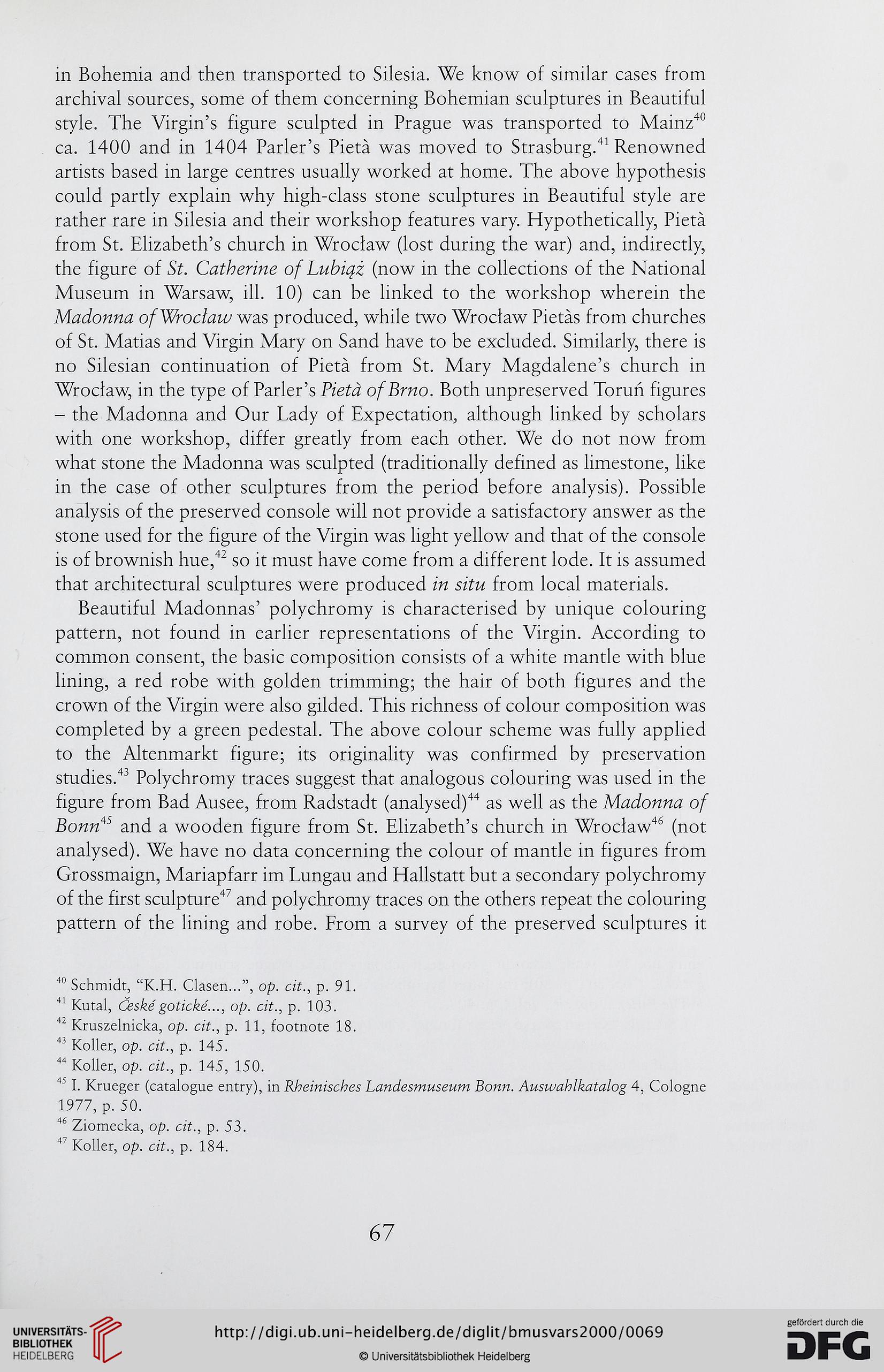in Bohemia and then transported to Silesia. We know of similar cases from
archival sources, some of them concerning Bohemian sculptures in Beautiful
style. The Virgin’s figurę sculpted in Prague was transported to Mainz40
ca. 1400 and in 1404 Parler’s Pieta was moved to Strasburg.41 Renowned
artists based in large centres usually worked at home. The above hypothesis
could partly explain why high-class stone sculptures in Beautiful style are
rather rare in Silesia and their workshop features vary. Hypothetically, Pieta
from St. Elizabeth’s church in Wrocław (lost during the war) and, indirectly,
the figurę of St. Catherine of Lubiąż (now in the collections of the National
Museum in Warsaw, ill. 10) can be linked to the workshop wherein the
Madonna of Wrocław was produced, while two Wrocław Pietas from churches
of St. Matias and Virgin Mary on Sand have to be excluded. Similarly, there is
no Silesian continuation of Pieta from St. Mary Magdalene’s church in
Wrocław, in the type of Parler’s Pieta ofBrno. Both unpreserved Toruń figures
- the Madonna and Our Lady of Expectation, although linked by scholars
with one workshop, differ greatly from each other. We do not now from
what stone the Madonna was sculpted (traditionally defined as limestone, like
in the case of other sculptures from the period before analysis). Possible
analysis of the preserved console will not provide a satisfactory answer as the
stone used for the figurę of the Virgin was light yellow and that of the console
is of brownish hue,42 so it must have come from a different lode. It is assumed
that architectural sculptures were produced in situ from local materials.
Beautiful Madonnas’ polychromy is characterised by uniąue colouring
pattern, not found in earlier representations of the Virgin. According to
common consent, the basie composition consists of a white mantle with blue
lining, a red robę with golden trimming; the hair of both figures and the
crown of the Virgin were also gilded. This richness of colour composition was
completed by a green pedestal. The above colour scheme was fully applied
to the Altenmarkt figurę; its originality was confirmed by preservation
studies.4’ Polychromy traces suggest that analogous colouring was used in the
figurę from Bad Ausee, from Radstadt (analysed)44 as well as the Madonna of
Bonn4" and a wooden figurę from St. Elizabeth’s church in Wrocław46 47 (not
analysed). We have no data concerning the colour of mantle in figures from
Grossmaign, Mariapfarr im Lungau and Hallstatt but a secondary polychromy
of the first sculpture4/ and polychromy traces on the others repeat the colouring
pattern of the lining and robę. From a survey of the preserved sculptures it
40 Schmidt, “K.H. Clasen...”, op. cit., p. 91.
41 Kutal, Ćeske goticke..., op. cit., p. 103.
42 Kruszelnicka, op. cit., p. 11, footnote 18.
43 Koller, op. cit., p. 145.
44 Koller, op. cit., p. 145, 150.
4' I. Krueger (catalogue entry), in Rheinisches Landesmuseum Borni. Auswahlkatalog 4, Cologne
1977, p. 50.
46 Ziomecka, op. cit., p. 53.
47 Koller, op. cit., p. 184.
67
archival sources, some of them concerning Bohemian sculptures in Beautiful
style. The Virgin’s figurę sculpted in Prague was transported to Mainz40
ca. 1400 and in 1404 Parler’s Pieta was moved to Strasburg.41 Renowned
artists based in large centres usually worked at home. The above hypothesis
could partly explain why high-class stone sculptures in Beautiful style are
rather rare in Silesia and their workshop features vary. Hypothetically, Pieta
from St. Elizabeth’s church in Wrocław (lost during the war) and, indirectly,
the figurę of St. Catherine of Lubiąż (now in the collections of the National
Museum in Warsaw, ill. 10) can be linked to the workshop wherein the
Madonna of Wrocław was produced, while two Wrocław Pietas from churches
of St. Matias and Virgin Mary on Sand have to be excluded. Similarly, there is
no Silesian continuation of Pieta from St. Mary Magdalene’s church in
Wrocław, in the type of Parler’s Pieta ofBrno. Both unpreserved Toruń figures
- the Madonna and Our Lady of Expectation, although linked by scholars
with one workshop, differ greatly from each other. We do not now from
what stone the Madonna was sculpted (traditionally defined as limestone, like
in the case of other sculptures from the period before analysis). Possible
analysis of the preserved console will not provide a satisfactory answer as the
stone used for the figurę of the Virgin was light yellow and that of the console
is of brownish hue,42 so it must have come from a different lode. It is assumed
that architectural sculptures were produced in situ from local materials.
Beautiful Madonnas’ polychromy is characterised by uniąue colouring
pattern, not found in earlier representations of the Virgin. According to
common consent, the basie composition consists of a white mantle with blue
lining, a red robę with golden trimming; the hair of both figures and the
crown of the Virgin were also gilded. This richness of colour composition was
completed by a green pedestal. The above colour scheme was fully applied
to the Altenmarkt figurę; its originality was confirmed by preservation
studies.4’ Polychromy traces suggest that analogous colouring was used in the
figurę from Bad Ausee, from Radstadt (analysed)44 as well as the Madonna of
Bonn4" and a wooden figurę from St. Elizabeth’s church in Wrocław46 47 (not
analysed). We have no data concerning the colour of mantle in figures from
Grossmaign, Mariapfarr im Lungau and Hallstatt but a secondary polychromy
of the first sculpture4/ and polychromy traces on the others repeat the colouring
pattern of the lining and robę. From a survey of the preserved sculptures it
40 Schmidt, “K.H. Clasen...”, op. cit., p. 91.
41 Kutal, Ćeske goticke..., op. cit., p. 103.
42 Kruszelnicka, op. cit., p. 11, footnote 18.
43 Koller, op. cit., p. 145.
44 Koller, op. cit., p. 145, 150.
4' I. Krueger (catalogue entry), in Rheinisches Landesmuseum Borni. Auswahlkatalog 4, Cologne
1977, p. 50.
46 Ziomecka, op. cit., p. 53.
47 Koller, op. cit., p. 184.
67




